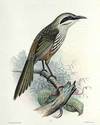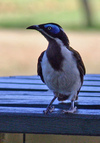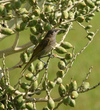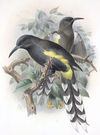Family Meliphagidae
Acanthagenys - The honeyeater is mainly frugivorous, but will also eat nectar, blossoms, insects, reptiles, and young birds.
Acanthorhynchus - Spinebill is name given to two members of the Honeyeater family, both in the genus Acanthorhynchus, the name of which means literally "spine bill".
Anthochaera - Wattlebirds are characterized by their wattles.
Anthornis - The bellbird is found throughout both the main islands of New Zealand apart from the north of the North Island.
Ashbyia - The Gibberbird is 11–14 cm long and weighs 14-20 g.
Certhionyx - Certhionyx is a genus of bird in the honeyeater family Meliphagidae.
Chaetoptila - The cause of its extinction is unknown.
Conopophila - Conopophila is a genus of bird in the Meliphagidae family.
Entomyzon - Originally described as Gracula cyanotis by ornithologist John Latham in 1802, though he also considered Merops and Turdus .
Epthianura - The genus Epthianura is endemic to the continent of Australia, where they are widely distributed across the mainland and, in the case of the White-fronted Chat, Tasmania.
Foulehaio - The species is endemic to the islands of the Central Pacific, occurring on American Samoa, Fiji, Samoa, Tonga, and Wallis and Futuna Islands.
Glycichaera - The Green-backed Honeyeater is a species of bird in the Meliphagidae family.
Grantiella - It is endemic to Australia.
Guadalcanaria - The Guadalcanal Honeyeater is a species of bird in the Meliphagidae family.
Gymnomyza - There are three species.
Lichenostomus - Lichenostomus is a relatively large genus of honeyeaters .
Lichmera - Lichmera is a genus of bird in the honeyeater family Meliphagidae.
Macgregoria - Macgregoria may refer to:
Manorina - Manorina is a genus of Australian endemic honeyeaters, containing four species: the Black-eared Miner, M.
Melidectes - They are medium sized honeyeaters, varied in appearance but possessing a long and sometimes stout bill and bare patch around the eye which is quite large and brightly coloured in some species.
Melilestes - The Long-billed Honeyeater is a species of bird in the Meliphagidae family.
Meliphaga - Meliphaga is a genus of bird in the Meliphagidae family.
Melipotes - Melipotes contains the following species:
Melithreptus - Melithreptus is a genus of bird in the Meliphagidae family.
Melitograis - Its natural habitats are subtropical or tropical moist lowland forests, subtropical or tropical mangrove forests, and subtropical or tropical moist montane forests.
Moho - Moho may refer to:
Myza - Myza is a genus of bird in the Meliphagidae family.
Myzomela - Myzomela is a genus of bird in the honeyeater family Meliphagidae.
Notiomystis - The Stitchbird is a small honeyeater-like bird with a dark velvety cap and white ear-tufts.
Oreornis - The Orange-cheeked Honeyeater is a species of bird in the Meliphagidae family.
Philemon - People:
Phylidonyris - The genus Phylidonyris is a member of the Honeyeater family.
Plectorhyncha - The Striped Honeyeater is a medium-sized bird with an average length of 22cm.
Prosthemadera - The name Tui is from the Maori language name tūī and is the species' formal common name.
Ptiloprora - Ptiloprora is a genus of bird in the Meliphagidae family.
Pycnopygius - Pycnopygius is a genus of bird in the Meliphagidae family.
Ramsayornis - Ramsayornis is a genus of bird in the Meliphagidae family.
Stresemannia - The Bougainville Honeyeater is a species of bird in the Meliphagidae family.
Timeliopsis - Timeliopsis is a genus of bird in the Meliphagidae family.
Trichodere - Its natural habitat is subtropical or tropical dry forests.
Xanthomyza - Recent genetic research suggests it is closely related to the wattlebirds.
Xanthotis - Xanthotis is a genus of bird in the Meliphagidae family.
















